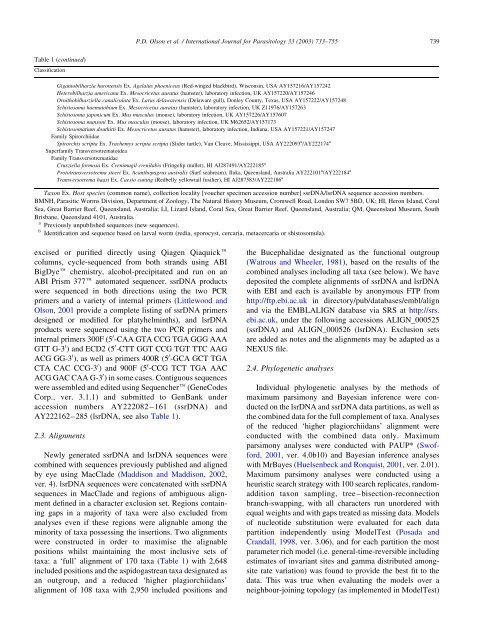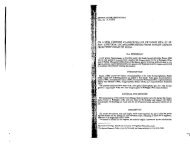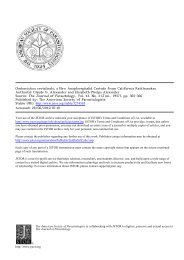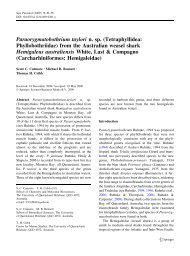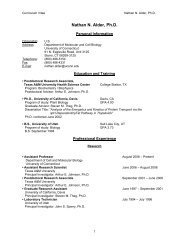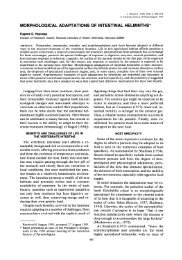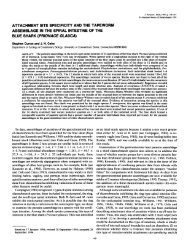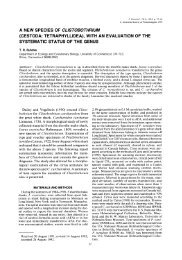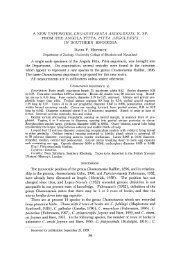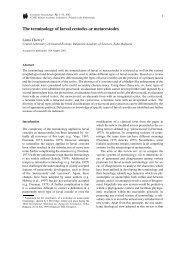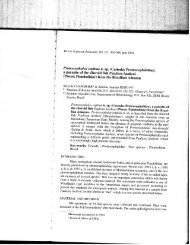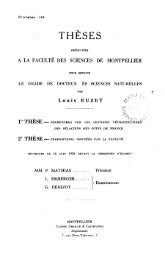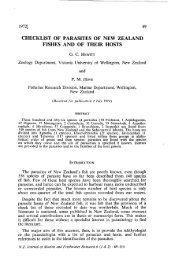Phylogeny and classification of the Digenea (Platyhelminthes ...
Phylogeny and classification of the Digenea (Platyhelminthes ...
Phylogeny and classification of the Digenea (Platyhelminthes ...
You also want an ePaper? Increase the reach of your titles
YUMPU automatically turns print PDFs into web optimized ePapers that Google loves.
P.D. Olson et al. / International Journal for Parasitology 33 (2003) 733–755 739Table 1 (continued)ClassificationGigantobilharzia huronensis Ex. Agelaius phoeniceus (Red-winged blackbird), Wisconsin, USA AY157216/AY157242Heterobilharzia americana Ex. Mesocricetus auratus (hamster), laboratory infection, UK AY157220/AY157246Ornithobilharziella canaliculata Ex. Larus delawarensis (Delaware gull), Donley County, Texas, USA AY157222/AY157248Schistosoma haematobium Ex. Mesocricetus auratus (hamster), laboratory infection, UK Z11976/AY157263Schistosoma japonicum Ex. Mus musculus (mouse), laboratory infection, UK AY157226/AY157607Schistosoma mansoni Ex. Mus musculus (mouse), laboratory infection, UK M62652/AY157173Schistosomatium douthitti Ex. Mesocricetus auratus (hamster), laboratory infection, Indiana, USA AY157221/AY157247Family SpirorchiidaeSpirorchis scripta Ex. Trachemys scripta scripta (Slider turtle), Van Cleave, Mississippi, USA AY222093 a /AY222174 aSuperfamily TransversotrematoideaFamily TransversotrematidaeCrusziella formosa Ex. Crenimugil crenilabis (Fringelip mullet), HI AJ287491/AY222185 aPrototransversotrema steeri Ex. Acanthopagrus australis (Surf seabream), Iluka, Queensl<strong>and</strong>, Australia AY222101 a /AY222184 aTransversotrema haasi Ex. Caesio cuning (Redbelly yellowtail fusilier), HI AJ287583/AY222186 aTaxon Ex. Host species (common name), collection locality [voucher specimen accession number] ssrDNA/lsrDNA sequence accession numbers.BMNH, Parasitic Worms Division, Department <strong>of</strong> Zoology, The Natural History Museum, Cromwell Road, London SW7 5BD, UK; HI, Heron Isl<strong>and</strong>, CoralSea, Great Barrier Reef, Queensl<strong>and</strong>, Australia; LI, Lizard Isl<strong>and</strong>, Coral Sea, Great Barrier Reef, Queensl<strong>and</strong>, Australia; QM, Queensl<strong>and</strong> Museum, SouthBrisbane, Queensl<strong>and</strong> 4101, Australia.a Previously unpublished sequences (new sequences).b Identification <strong>and</strong> sequence based on larval worm (redia, sporocyst, cercaria, metacercaria or shistosomula).excised or purified directly using Qiagen Qiaquickecolumns, cycle-sequenced from both str<strong>and</strong>s using ABIBigDyee chemistry, alcohol-precipitated <strong>and</strong> run on anABI Prism 377e automated sequencer. ssrDNA productswere sequenced in both directions using <strong>the</strong> two PCRprimers <strong>and</strong> a variety <strong>of</strong> internal primers (Littlewood <strong>and</strong>Olson, 2001 provide a complete listing <strong>of</strong> ssrDNA primersdesigned or modified for platyhelminths), <strong>and</strong> lsrDNAproducts were sequenced using <strong>the</strong> two PCR primers <strong>and</strong>internal primers 300F (5 0 -CAA GTA CCG TGA GGG AAAGTT G-3 0 ) <strong>and</strong> ECD2 (5 0 -CTT GGT CCG TGT TTC AAGACG GG-3 0 ), as well as primers 400R (5 0 -GCA GCT TGACTA CAC CCG-3 0 ) <strong>and</strong> 900F (5 0 -CCG TCT TGA AACACG GAC CAA G-3 0 ) in some cases. Contiguous sequenceswere assembled <strong>and</strong> edited using Sequenchere (GeneCodesCorp., ver. 3.1.1) <strong>and</strong> submitted to GenBank underaccession numbers AY222082– 161 (ssrDNA) <strong>and</strong>AY222162–285 (lsrDNA, see also Table 1).2.3. AlignmentsNewly generated ssrDNA <strong>and</strong> lsrDNA sequences werecombined with sequences previously published <strong>and</strong> alignedby eye using MacClade (Maddison <strong>and</strong> Maddison, 2002,ver. 4). lsrDNA sequences were concatenated with ssrDNAsequences in MacClade <strong>and</strong> regions <strong>of</strong> ambiguous alignmentdefined in a character exclusion set. Regions containinggaps in a majority <strong>of</strong> taxa were also excluded fromanalyses even if <strong>the</strong>se regions were alignable among <strong>the</strong>minority <strong>of</strong> taxa possessing <strong>the</strong> insertions. Two alignmentswere constructed in order to maximise <strong>the</strong> alignablepositions whilst maintaining <strong>the</strong> most inclusive sets <strong>of</strong>taxa: a ‘full’ alignment <strong>of</strong> 170 taxa (Table 1) with 2,648included positions <strong>and</strong> <strong>the</strong> aspidogastrean taxa designated asan outgroup, <strong>and</strong> a reduced ‘higher plagiorchiidans’alignment <strong>of</strong> 108 taxa with 2,950 included positions <strong>and</strong><strong>the</strong> Bucephalidae designated as <strong>the</strong> functional outgroup(Watrous <strong>and</strong> Wheeler, 1981), based on <strong>the</strong> results <strong>of</strong> <strong>the</strong>combined analyses including all taxa (see below). We havedeposited <strong>the</strong> complete alignments <strong>of</strong> ssrDNA <strong>and</strong> lsrDNAwith EBI <strong>and</strong> each is available by anonymous FTP fromhttp://ftp.ebi.ac.uk in directory/pub/databases/embl/align<strong>and</strong> via <strong>the</strong> EMBLALIGN database via SRS at http://srs.ebi.ac.uk, under <strong>the</strong> following accessions ALIGN_000525(ssrDNA) <strong>and</strong> ALIGN_000526 (lsrDNA). Exclusion setsare added as notes <strong>and</strong> <strong>the</strong> alignments may be adapted as aNEXUS file.2.4. Phylogenetic analysesIndividual phylogenetic analyses by <strong>the</strong> methods <strong>of</strong>maximum parsimony <strong>and</strong> Bayesian inference were conductedon <strong>the</strong> lsrDNA <strong>and</strong> ssrDNA data partitions, as well as<strong>the</strong> combined data for <strong>the</strong> full complement <strong>of</strong> taxa. Analyses<strong>of</strong> <strong>the</strong> reduced ‘higher plagiorchiidans’ alignment wereconducted with <strong>the</strong> combined data only. Maximumparsimony analyses were conducted with PAUP* (Sw<strong>of</strong>ford,2001, ver. 4.0b10) <strong>and</strong> Bayesian inference analyseswith MrBayes (Huelsenbeck <strong>and</strong> Ronquist, 2001, ver. 2.01).Maximum parsimony analyses were conducted using aheuristic search strategy with 100 search replicates, r<strong>and</strong>omadditiontaxon sampling, tree–bisection-reconnectionbranch-swapping, with all characters run unordered wi<strong>the</strong>qual weights <strong>and</strong> with gaps treated as missing data. Models<strong>of</strong> nucleotide substitution were evaluated for each datapartition independently using ModelTest (Posada <strong>and</strong>Cr<strong>and</strong>all, 1998, ver. 3.06), <strong>and</strong> for each partition <strong>the</strong> mostparameter rich model (i.e. general-time-reversible includingestimates <strong>of</strong> invariant sites <strong>and</strong> gamma distributed amongsiterate variation) was found to provide <strong>the</strong> best fit to <strong>the</strong>data. This was true when evaluating <strong>the</strong> models over aneighbour-joining topology (as implemented in ModelTest)


